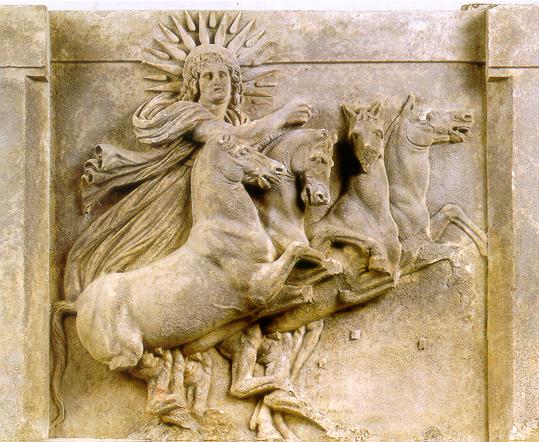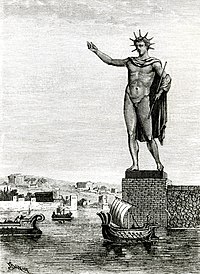
As I explain in Vergina Sun.....a Pan-Hellenic Symbol the e "Macedonian Star" or "Sun of Vergina" is the continuation of the oldest ancient Greek symbol of the Sun. Helios, the sun god of the ancient Greeks, was usually represented riding a chariot which was drawn by four, often winged, horses . His chariot rose daily into the heavens from the east and after blazing across the sky plunged into the western sea, thus bringing on the night. The sun's brilliant light emanated from the fiery crown that adorned Helios's head.
Helios is the Greek sun god and the sun itself. He is equated with the Roman Sol. Helios drives a chariot led by 4 fire-breathing horses across the sky each day. At night he is carried back to his starting place in a great cup. The best known story involving Helios is that of his son Phaëton, who attempted to drive his father's chariot but lost control and set the earth on fire.
Helios was sometimes referred to with the epithet Helios Panoptes ("the all-seeing"). In the story told in the hall of Alcinous in the Odyssey (viii.300ff), Aphrodite, the consort of Hephaestus, secretly beds Ares, but all-seeing Helios spies on them and tells Hephaestus, who ensnares the two lovers in nets invisibly fine, to punish them. Helios is sometimes identified with Apollo; "Different names may refer to the same being," Walter Burkert observes, "or else they may be consciously equated, as in the case of Apollo and Helios."
In Homer, Apollo is clearly identified as a different god, a plague-dealer with a silver (not golden) bow and no solar features. At the picture in the first of the top and is from an ancient Greek vase you can see the god Helios/Sun riding his solar chariot which is drawn by four winged horses.
In the below picture you can see a Corner block of a frieze of metopes and triglyphs depicting Helios from the Temple of Athena at Troy( 300 BCE) that located on Pergamum Museum.

This relief metope depicting Helios is the best preserved of all the metopes from the Temple of Athena at Troy. The sun God's team of four horses is shown tempestuously charging out from the sea. A diadem-like rayed halo surrounds the God's head. The sweeping surge of the team is emphasized by the deep, fluttering folds of Helios' garments and the diagonal, echeloned arrangement of the horses.
The dimensions of this marble are
h. 85.8cm,
w. 2.012m
w. of metope 86.3cm
The sun god made the frits of the earth ripen - fertility being a common and obvious symbol logical association of the sun. When swearing an oath Greeks would often call upon Helios as a witness, as they believed he "saw and heard everything".
Although originally distinct deities, Helios was confused, as early as the fifth century BC, with Apollo (originally the god of music, the arts, archery, healing and prophecy - and later of light), so that Apollo frequently took on the function of the sun god himself. The epithets Phoebus 'the brilliant", Xanthos "the fair" and Chrysokomes "of the golden locks" used to describe Apollo, point to this solar connection.
The liveliest cult of Helios in the ancient Greek world existed on the island of Rhodes. Each year during the Halieia festival which was celebrated with much splendor and with athletic contests, the Rhodians threw a team of four horses into the sea as a sacrifice to him. In honor of what was effectively their national deity and to commemorate their heroic defense against Demetrius Poliorcetes's array, the people of Rhodes commissioned the celebrated sculptor Chares of Lindos to create a huge statue of Helios.
This statue, which is known to us as the 'Colossus of Rhodes", was one of the wonders of the ancient world. It was completed in 292 BC, twelve years after work began on it. It stood at the entrance of Rhodes's harbor and was over 35 meters tall. Helios was represented with a crown of sun-rays, a spear in his left hand and a flaming torch held aloft in his right, as depicted in the below illustration .

Descriptions of this ancient statue inspired the design of France's gift to the people of the USA in 1884 - the Statue of Liberty as the inscription at the base of this New York landmark acknowledges.
Less than a century after its completion (in 224 BC), an earthquake destroyed the statue and it was never again erected. The metal was finally sold for scrap in 653 AD.
The rays emanating from the sun god's head, as they must have appeared on the Rhodian statue's crown, and as we know them to actually be depicted on surviving works of art, reinforce the conviction that the inspiration for the Sunburst derives from the traditional representation of the Greek sun god Helios. It is not difficult to see that stylized rays emanating from a fiery core is in fact a shorthand reference to this solar deity rather than to a star.
In Late Antiquity a cult of Helios Megistos ("Great Helios") drew to the image of Helios a number of syncretic elements, which have been analysed in detail by Wilhelm Fauth by means of a series of late Greek texts, namely: an Orphic Hymn to Helios; the so-called Mithras Liturgy, where Helios rules the elements; spells and incantations invoking Helios among the Greek Magical Papyri; a Hymn to Helios by Proclus; Julian's Oration to Helios, the last stand of official paganism; and an episode in Nonnus' Dionysiaca.
sources
- The Rays of the Sun God by macedoniansincanada.com
- http://www.goddess-athena.org
- Walter Burkett, Greek Religion
- Karl Kerenyi, The Gods of the Greeks - "The Sun, the Moon and their Family"
- Wilhelm Fauth, Helios Megistos: zur synkretistischen Theologie der Spätantike (Leiden:Brill) 1995






No comments:
Post a Comment